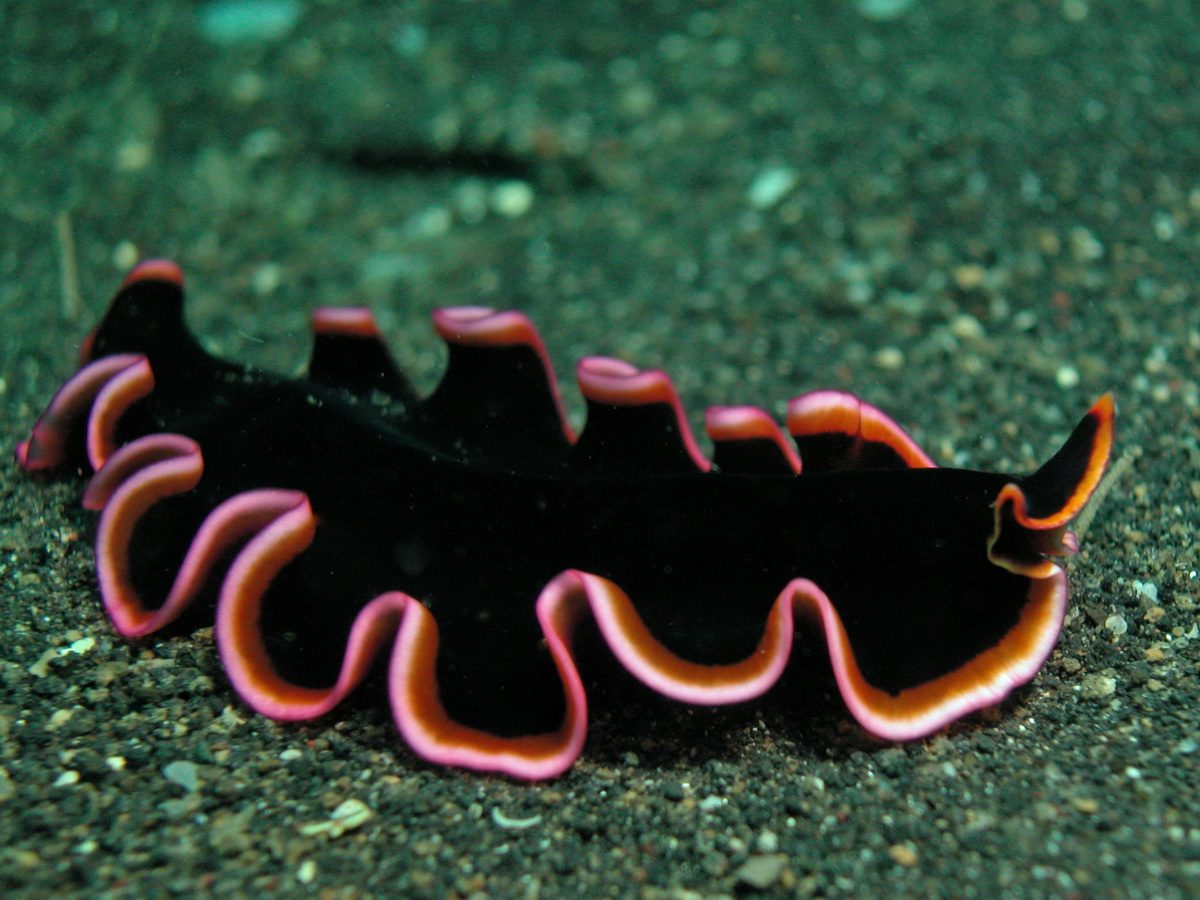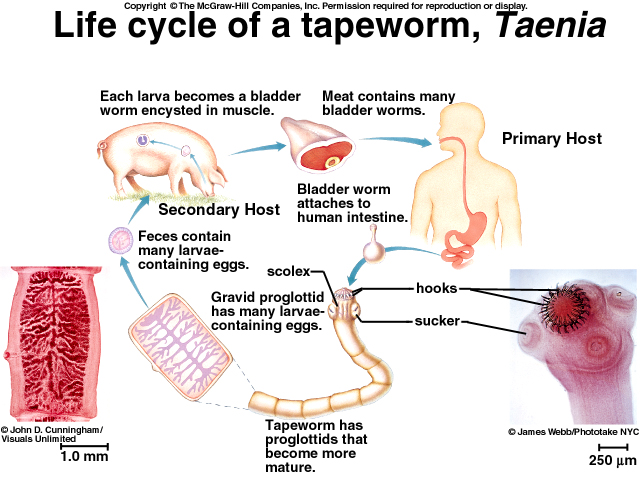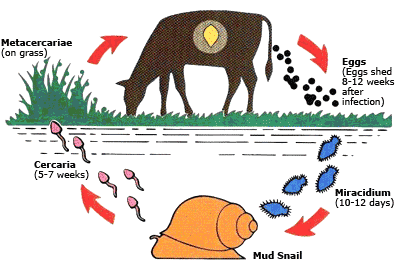Phylum Platyhelminthes
- many of the species are parasites
- others are free-living freshwater and marine species
 |
| Soure: http://sharon-taxonomy2009-p2.wikispaces.com/Platyhelminthes |
Structure
- dorso-ventrally flattened (dorso- refers to the back and ventral refers to the belly) and they have no cavity (space) inside their bodies, so we call them acoelomates
 |
| Source: https://www.studyblue.com/notes/note/n/platyhelminthes/deck/8590257 In the image, 1 is the epidermis, 2 is the gut, 3 is the mesoderm (body wall), 4 is the endoderm and 5 is the ectoderm. |
- have 3 germ layers (triploblastic), each layer gives rise to specialized tissues, which combine to form organs.
- digestive system: they have one opening that functions like a mouth and an anus, it takes in food and releases wastes. It is called an eversible pharynx (kiölthető garat). This opening developed from the blastopore, so we say that they are protostomes (ősszájúak). They have a branched gut.
 |
| Source:https://www.studyblue.com/notes/note/n/platyhelminthes/deck/8590257 |
 |
| Source: https://yhsbiology.wikispaces.com/Platyhelminthes |
- cephalization (cephalo- refers to a "head" or "brain): in flatworms there is a precursor to a brain, with 2 ganglia (idegdúc) and 2 nerve cords, that regulate the animal and make them better at moving, feeding, mating, etc. We call this kind of nervous system a ganglionic nervous system (dúcidegrendszer). Some flatworms have eyespots located right above the 2 ganglia. These are special cells that react to light and dark.
Classification
1. Turbellaria (örvényférgek)
This group includes all the free-living flatworms. They are generally called planarians. Mostly commonly they are found in freshwater (usually this guys are small, 1-2cm) or marine environments (these guys are larger, 5-10cm, and way more colourful). They are predators. They are covered with cilia and produce mucus to help with movement.
 |
 |
| Source: http://www2.estrellamountain.edu/faculty/farabee/biobk/BioBookEXCRET.html |
 |
They also reproduce sexually. They are hermaphrodites, so they cross-fertilize.
 |
| Reproductive system of a planarian |
2. Trematoda (szívóférgek)
These flatworms are generally called flukes (métely). They are internal or external parasites and usually have leaf-shaped bodies with 2 suckers (szívókorong) to hold onto the host. Because of their parasitic lifestyle, some of their organ systems have altered a bit from the free-living flatworms. For example, they don't have such a well-developed nervous system and they have no eyespots. On the other hand, their reproductive organs are VERY well developed!
 |
| Blood fluke (causes schistosomiasis) |
 |
| Life cycle of a blood fluke |
| F |
3. Cestoda (galandférgek)
 |
| Proglottids of a tapeworm |
 |
Phylum Nematoda
These are the roundworms (hengeresfergek).
- have adapted to almost every ecosystem (in soil, freshwater and saltwater), many are parasitic
Structure
- smooth cylindrical bodies, tapered at both ends
- body covered by a thick, protective cuticle and often have bristles
- smooth cylindrical bodies, tapered at both ends
- body covered by a thick, protective cuticle and often have bristles
- pseudocoelomates: This means they have a body cavity (space) that forms between the endoderm and the mesoderm
 |
-nervous system: have a nerve ring in the "head" region that functions like a brain. It is attached to 4 nerve cords (dorsal, ventral and 2 lateral)-digestive system: a new hole is formed, the anus!!!! (they are still protostomes, the mouth develops from the blastopore). Now there is one-way flow through the digestive system from the mouth to the anus. This is much more efficient! Roundworms have a piercing mouthpart that they use to attach to host, or pierce their prey.
- no circulatory or respiratory organs
- excretory system: release of nitrogenous wastes through excretory pores
- muscular system: long muscles run the length of the worm, so they have a whip-like wiggle motion (undulatory propulsion)
 |
| Roundworm organ systems |
- reproductive system: separate sexes, most of their body cavity (pseudocoelom) is filled with paired sets of reproductive organs, either ovaries or testes. Male introduces sperm to the female's vagina with the help of 2 stiff horny spicules that are a part of his cloaca. Fertilisation is internal and females lay eggs over a long time period (for example, a female Ascaris lumbricoides may lay her eggs at the rate of 200,000 per day and have had a total 27 million eggs within her at the start of her reproductive career).
 |
| Roundworm reproductive structures |
Young nematodes hatch from these eggs and go through 4 moults before they become adults. Eggs are tough enough to survive years outside a host (if parasite). Below are some parasite life cycles.
Phylum Annelida
- also called segmented or ringed worms (gyűrűsférgek)- found in soil, freshwater and saltwater
Structure
- Bilateral symmetry, 3 germ layers
- thin, tough cuticle, doesn't affect gas exchange
- bristles on body surface
- protostomes
-coelomates: have a fluid-filled cavity (space) that forms between 2 mesoderm layers
 |
- digestive system: development of different organs within the digestive tract (tápcsatorna). Mouth (garat), esophagus (nyelőcső), crop (begy) - stores food temporarily, gizzard (zuza) - grinds food, intestine (bél) - absorbs food, anus (végbél) - excretes soil
 |
| Digestive system of an earthworm |
- nervous system: advanced ganglionic nervous system. There is a simple brain (cerebral ganglia) above the mouth, a ventral chain of ganglia (hasdúclánc) attached to a nerve cord and nerve fibres in each segment.
- respiratory system: most have no special organs, gas exchange occurs at the body surface
- circulatory system: it is a closed system (zárt keringési rendszer), so the blood runs through dorsal and ventral blood vessels. They have 5 simple hearts (enlarged muscular vessels)
- excretory system: in each segment there is a pair of coiled tubules, called nephridia (vesécskék) that remove nitrogenous wastes from the coelomic fluid. |
- muscular system: the muscles are connected to the skin (bőrizomtömlő). There are circular muscles with contract the diameter of a segment, and there are longitunidal muscles that contract the width or length of a segment. Together they allow the worm to crawl forward in a coordinated manner
Classification
1. Polychaetes (soksertéjű gyűrűsférgek)
- largest
- various body structures, but all have lots of bristles (serte)
 |
| Eunice pennata |
 |
| Bispira manicata |
2. Oligochaetes (kevéssertéjű gyűrűsférgek)
- have few bristles
- live in freshwater or soil
eg. earthworm
 |
| Tubifex worm |
3. Leeches (nadályok, piocák)
- muscular bodies with suckers at each end
- ectoparasites
- mostly aquatic
- lack bristles
 |














No comments:
Post a Comment